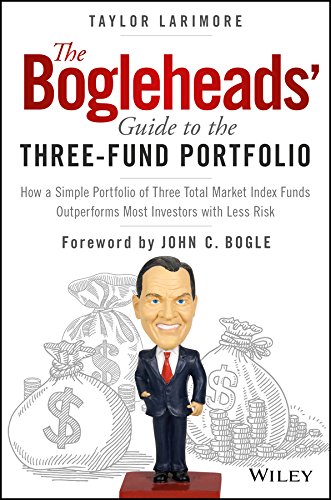Although I am a huge proponent of the Baby Steps, I do differ from the investing philosophy of Dave Ramsey. Dave teaches us to save with mutual funds, not individual stocks. Check. It’s not even so much Dave’s asset allocation that bothers me. It’s that he steers followers toward his Endorsed Local Providers, or ELPs.

Ramsey Solutions is a business concern, and getting a kickback from ELPs is their right. After all, they provide value to millions of people who don’t know how to invest.
It’s just that you can do it yourself cheaper using lazy portfolios. Why pay the high expense ratios of managed funds when SPIVA reports that 87% of actively managed funds have underperformed their respective markets over the last 15 years?
What is a lazy portfolio?

The lazy portfolio is characterized by low expense ratios, broad market coverage, low risk, and of course low effort!
My lazy fund of choice is the three-fund portfolio outlined in the book to the left. When I first learned how easy it was to use low-cost index funds to beat most professional investors, I was jazzed!
TL;DR
Although this book is not really thick, here’s the main takeaway. Investing through dollar cost averaging in total market index funds keeps costs low and beats the vast majority of professional money managers. Warren Buffett says the lower the expense ratio, the more money works for you, the investor.
Not only is this a low cost do-it-yourself option to wasting money on fund managers, but the 3-fund portfolio matches the market with almost no effort. The secret is the use of total market index funds.
What are these funds?
The first fund is a total stock market index. VTSAX is the mutual fund of choice. VTI is the equivalent ETF. The owner of this fund mirrors the performance of some 3600+ publicly-traded companies in the United States. Warren Buffett also says never to bet against America. Instead of betting on one horse, VTSAX bets on the whole race. And this broad diversification comes with a super-low expense ratio of 0.04%. That just $4 per $10,000 invested!
The second fund is a total bond market index. VBTLX is the mutual fund of choice, and BND is the ETF. This provides broad exposure to U.S. investment-grade bonds. Bonds can provide an hedge against stock market downturns. Benjamin Graham wrote about “age in bonds” in his quintessential The Intelligent Investor. VBTLX also has a low expense ratio at 0.05%
The third fund is a total international stock index. VTIAX is the fund of choice. VXUS is the ETF. With a low 0.11% expense ratio, this fund tracks companies all across the globe. This fund can be more volatile as it invests in both developed and emerging markets.
Asset Allocation
So VTSAX (VTI), VTIAX (VXUS), and VBTLX (BND) provide exposure to all U.S. companies, all international companies, and U.S. treasuries and mortgage-backed securities.
But in which ratio should these be held? Great question!
This is mostly a function of individuals’ risk tolerance. For example, if I were super risk averse, I would hold 52% in VBTLX as Benjamin Graham recommends — age in bonds.
I try to maintain 80/20 equities/bonds. Within my 80% equities, I am 80/20 domestic/international. Here what it looks like for me.
- VTSAX (VTI) 64%
- VTIAX (VXUS) 16%
- VBTLX (BND) 20%
Is there a catch?
Kinda… VTSAX, VTIAX, and VBTLX each require a $3000 minimum investment. And investments under $10,000 incur a $20 per year fee at Vanguard.
That’s why I included the equivalent ETF of each of these index funds — VTI, VXUS, and BND. These can be traded (i.e., bought) with no transaction fee within Vanguard portfolio. But — and here’s the catch — they require new investors to keep track of their asset allocation with each deposit. Periodically, astute investors will rebalance their portfolios to the preferred asset allocation. This ensures buying low and selling high.
But once the magic $10,000 mark is hit, the asset allocation can be automatically maintained in Vanguard with each new deposit.
As Always…
Thanks for reading! I hope this information provides food for thought. Remember that I am not a certified financial planner, a certified public accountant, a licensed real estate agent, etc. My content is for educational purposes. I am a math educator who happens to have a finance degree. Like they say, never take financial advice from a math teacher! (Do they really say that?)
But you should spend less than you earn, invest the difference, and stay out of debt!
I would so appreciate your sharing my content with anyone you feel could benefit. And if you would like a free exploratory conversation or just want to shoot the breeze about personal finances, call me and leave a message or send a text to 570-731-0425.